The island of Hawaii, also known as the Big Island, is home to an extraordinary variety of bird species. With its diverse habitats that range from dry lava fields to lush rainforests, the island offers ideal nesting and feeding grounds for both native and migratory birds.
From the Hawaii Amakihi and the I’iwi that are found only in the Hawaiian Islands, to the introduced species like the Common myna and the Northern cardinal, the Big Island boasts an avian paradise that attracts bird enthusiasts from across the world.
In this article, we’ll explore the unique birdlife on the Big Island of Hawaii and discuss the challenges that these birds face in their struggle to survive in the changing landscape.
1. Spotted Dove
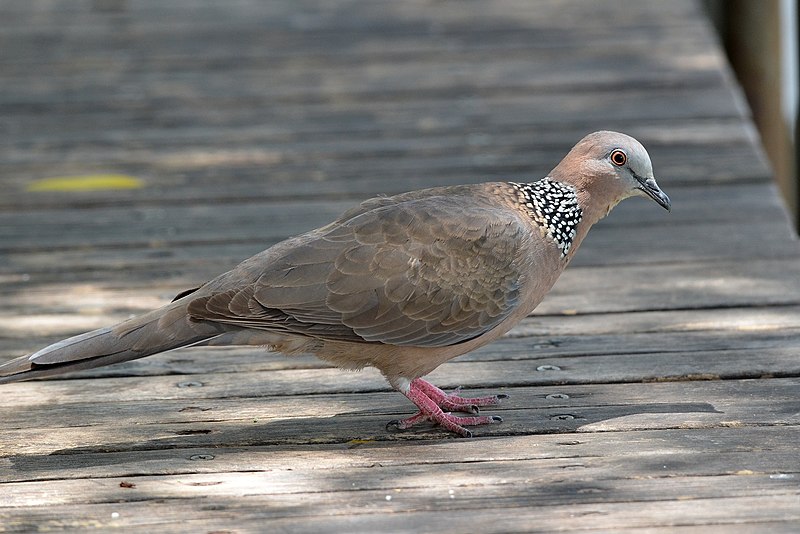
The Spotted Dove is a common species of pigeon found in the Indian subcontinent and Southeast Asia. It has an elegant, slender body with small head, long tail feathers and spotted wings.
Its coloring ranges from grey to brownish-grey on its upperparts with white underparts that are speckled black or dark grey. The male generally has more prominent spots than the female.
They feed mainly on seeds but will also consume insects when available during breeding season as well as berries, grains and fruits throughout their range.
These birds typically live in pairs or small groups near water sources such as ponds, rivers or streams where they can find food easily while staying safe from predators like cats and hawks.Scientific classification:
| Kingdom | Animalia |
| Phylum | Chordata |
| Class | Aves |
| Order | Columbiformes |
| Family | Columbidae |
| Genus | Spilopelia |
| Species | S. chinensis |
Also Featured In: Common Birds in India, Hong Kong Birds You Need to See
2. California Quail
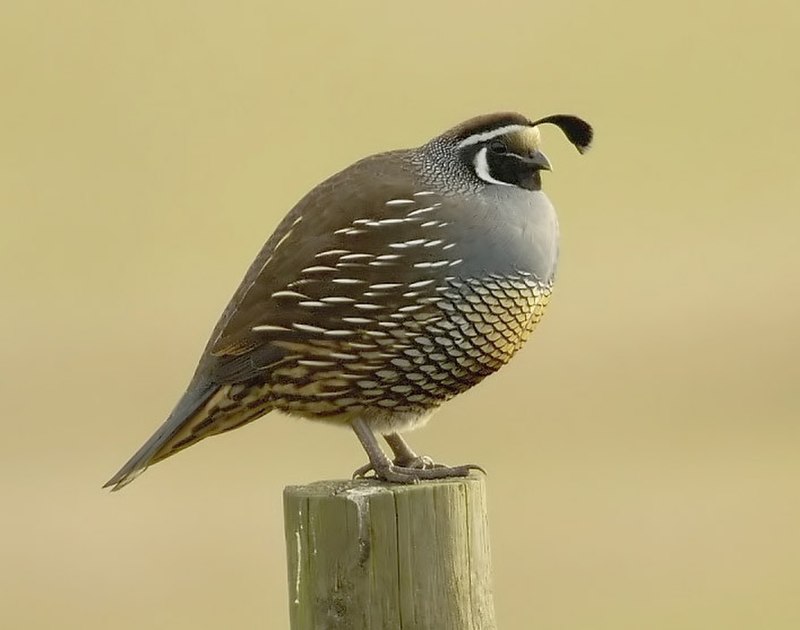
The California quail is a small, ground-dwelling bird with an iconic drooping crest. Male birds have a dark brown cap and black face while females sport a brown back and white streaks on their flanks.
These quails are found in the western United States and parts of northern Mexico and may gather in groups to feed or dust bathe together during the day.
Their diet consists mainly of grasses, seeds, berries as well as some insects like beetles or ants.
The population has been declining due to habitat loss so conservation efforts are being implemented for this species’ survival.Scientific classification:
| Kingdom | Animalia |
| Phylum | Chordata |
| Class | Aves |
| Order | Galliformes |
| Family | Odontophoridae |
| Genus | Callipepla |
| Species | C. californica |
Also Featured In: Most Common United States Birds, Birds that Live in San Francisco Bay Area
3. Nene
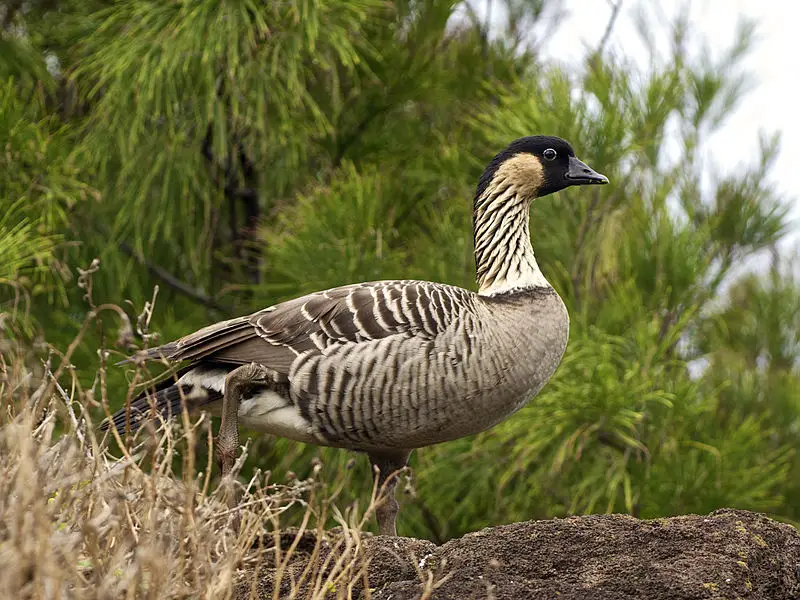
The Nene is a species of bird endemic to the Hawaiian Islands. It was given its name ‘nēnē’ due to its soft call and in 1957 it even became the official state bird of Hawaii.
This gorgeous goose can be found exclusively in the wild on islands such as Oahu, Maui, Kauaʻi, Molokai and Hawaiʻi.
The Nene has adapted so well to living within these different island environments that they have developed their own distinct subspecies depending on which island they are from.
These birds are an important part of Hawaiian culture, being featured in many stories throughout history where they were often seen as symbols for protection and good luck – making them truly special creatures indeed.Scientific classification:
| Kingdom | Animalia |
| Phylum | Chordata |
| Class | Aves |
| Order | Anseriformes |
| Family | Anatidae |
| Genus | Branta |
| Species | B. sandvicensis |
Also Featured In: Molokai Birds You Need To Know,
4. Chukar
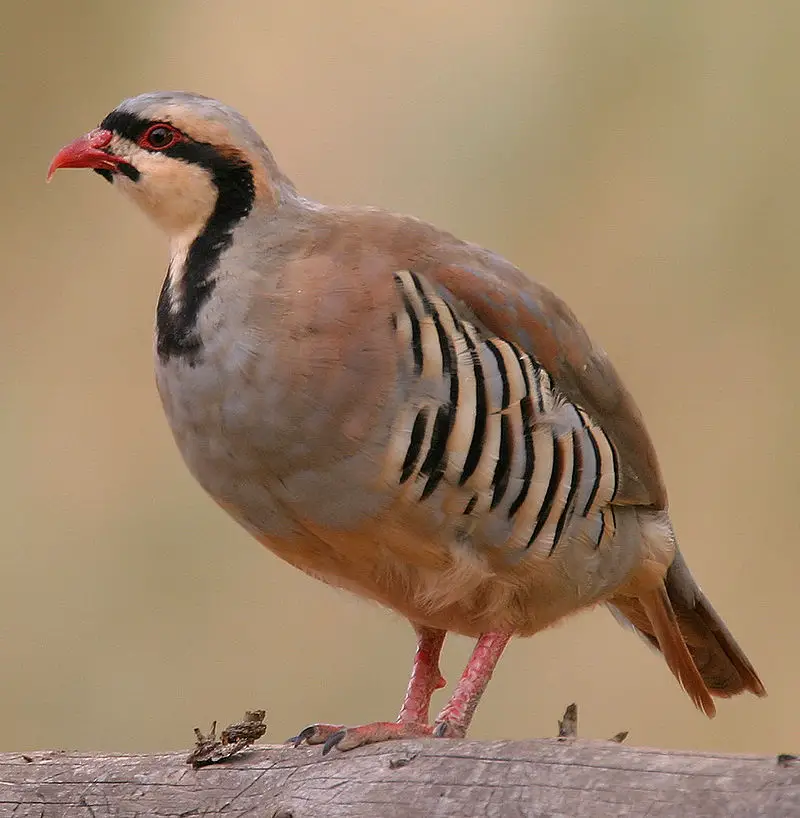
Chukar is a Palearctic upland gamebird belonging to the pheasant family. It has distinctive black and white bars on its flanks, as well as brown upperparts and buff underparts.
Its head is grey with an off-white face, throat and crest which turns chestnut in males during breeding season.
The Chukar typically lives in dry regions like open terrain or semi arid hillsides where it feeds mainly on seeds and invertebrates.
During winter months they tend to inhabit more wooded areas looking for shelter from harsh winds or snow storms.
They are social birds living in groups of up to 20 individuals but will pair off when mating season arrives.Scientific classification:
| Kingdom | Animalia |
| Phylum | Chordata |
| Class | Aves |
| Order | Galliformes |
| Family | Phasianidae |
| Genus | Alectoris |
| Species | A. chukar |
Also Featured In: Native Pakistani Birds, Birds That Live in Iraq
5. Kalij Pheasant
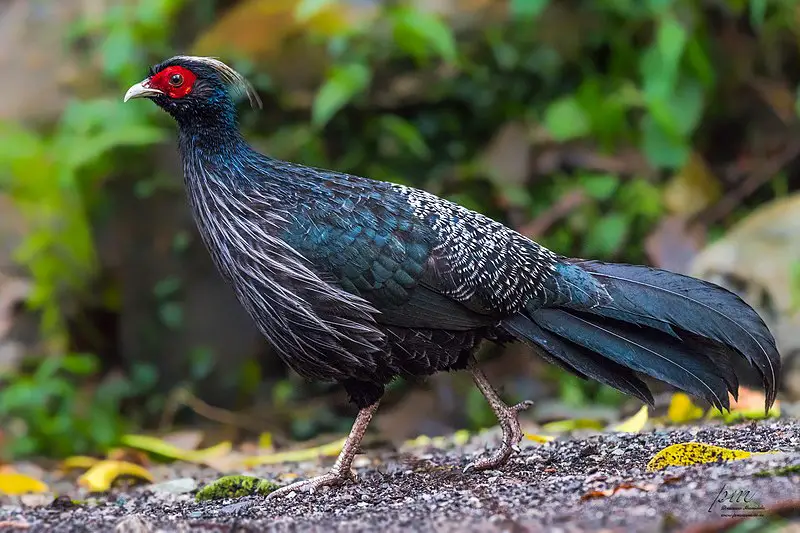
The Kalij Pheasant is a colourful bird found in forests and thickets of the Himalayan foothills, from Pakistan to western Thailand. Males have glossy bluish-black plumage with white markings on their wings, while females are overall brownish.
Both sexes feature a bare red face and grey legs that set them apart from other pheasants. They feed mainly on insects but will also eat seeds and grain when available, making them omnivores by nature.
When courting or displaying aggression towards rivals they create loud vocalisations as well as physical displays such as fluffing up feathers or fanning tails outwards.
These birds live alone during winter months but form pairs for mating season which typically occurs between March – May each year resulting in clutches of eggs being laid shortly after pairing off.Scientific classification:
| Kingdom | Animalia |
| Phylum | Chordata |
| Class | Aves |
| Order | Galliformes |
| Family | Phasianidae |
| Genus | Lophura |
| Species | L. leucomelanos |
Also Featured In: Birds that Live in Uttarakhand, Birds of Jim Corbett National Park
6. Zebra Dove
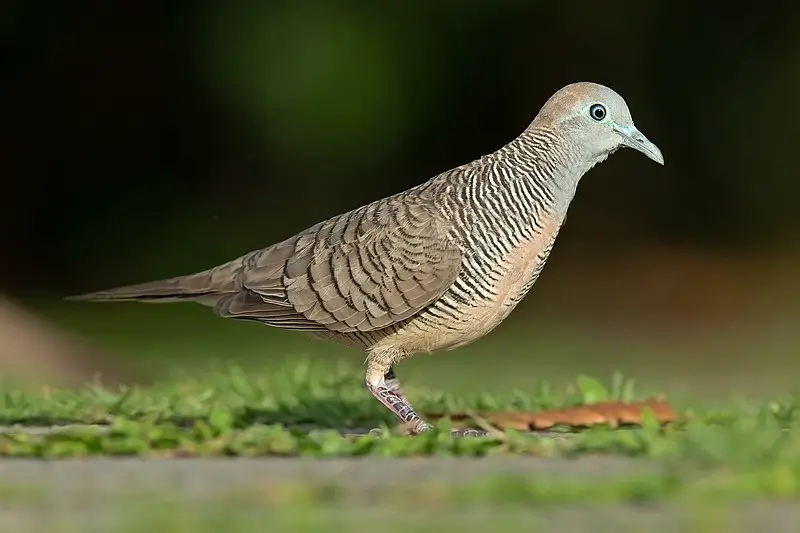
The Zebra Dove is a species of bird belonging to the Columbidae family. It can be found in Southeast Asia, and has predominantly brownish-grey feathers with black-and-white barring.
This dove stands out for its soft, pleasant cooing calls that sound like staccato notes when heard together. George Edwards first described it in 1743 as part of his English naturalist work on birds.
They are small animals with long tails, making them easily identifiable even from afar due to their distinct color patterning.
These doves prefer open woodlands or grassy areas near human settlements where they feed on seeds and insects while nesting close by but still far enough away from disturbance caused by humans or other animals who might disrupt their habitat.
The zebra dove is considered an important symbol among some Asian cultures representing love & beauty , reflecting how this little creature manages to capture people’s hearts wherever it goes.Scientific classification:
| Kingdom | Animalia |
| Phylum | Chordata |
| Class | Aves |
| Order | Columbiformes |
| Family | Columbidae |
| Genus | Geopelia |
| Species | G. striata |
Also Featured In: Birds of the Philippines, White Oahu Birds
7. Saffron Finch
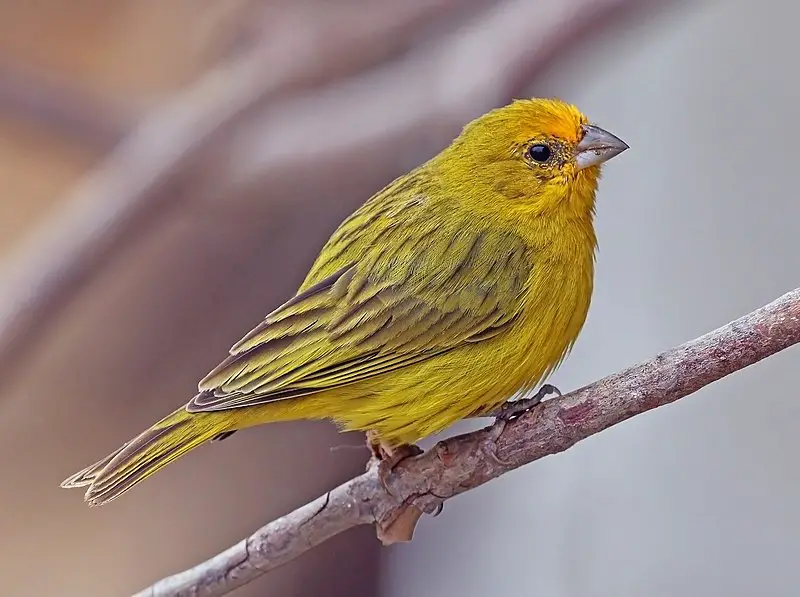
The Saffron Finch is a small tanager bird found in South America. This delightful species has an extensive distribution, ranging from Colombia to eastern Brazil and Bolivia.
They inhabit open or semi-open habitats at low elevations outside the Amazon Basin.
With their easily recognizable bright yellow feathers and cheerful song, they are often seen perching on roofs in northern Venezuela where they are referred to as “canario de tejado”.
In southern Brazil these birds are known as “canário-da-terra”, which translates into native canary.
Their diet consists mainly of seeds, grains and insects such as grasshoppers, caterpillars and beetles.
Although not threatened with extinction yet, deforestation may soon reduce their available habitat significantly if measures aren’t taken to conserve it now.Scientific classification:
| Kingdom | Animalia |
| Phylum | Chordata |
| Class | Aves |
| Order | Passeriformes |
| Family | Thraupidae |
| Genus | Sicalis |
| Species | S. flaveola |
Also Featured In: Birds of Argentina, Most Common Birds in South America Birds
8. Ruddy Turnstone
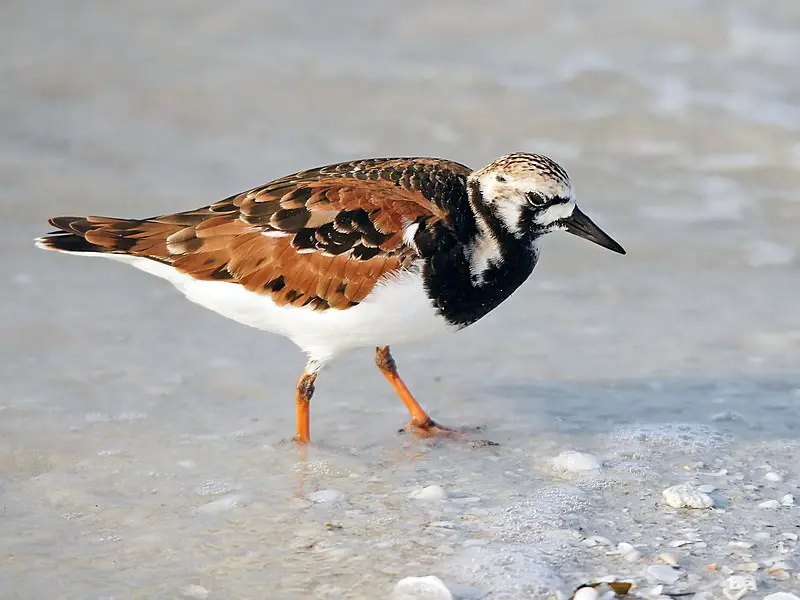
The Ruddy Turnstone is a small wading bird, belonging to the sandpiper family Scolopacidae. It has an attractive reddish-brown coloration and black patches on its back and wings.
This species breeds in northern parts of Eurasia and North America during summertime before migrating southwards in winter season to coastlines all over the world.
The Ruddy Turnstone feeds mainly on insects, mollusks, crustaceans, worms and some plant material such as seeds or berries which it finds by probing into mudflats with its bill.
It also uses stones for turning them when searching for food under rocks or pebbles along shorelines where they can often be seen darting around looking very busy.Scientific classification:
| Kingdom | Animalia |
| Phylum | Chordata |
| Class | Aves |
| Order | Charadriiformes |
| Family | Scolopacidae |
| Genus | Arenaria |
| Species | A. interpres |
Also Featured In: Birds of Netherlands, Galapagos Birds You Should Know
9. Yellow-Billed Cardinal
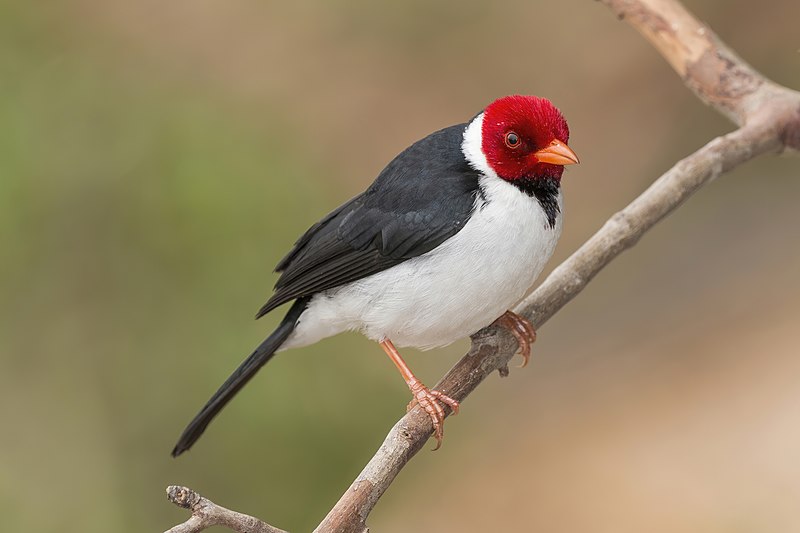
The Yellow-billed Cardinal is a striking bird found in the tropical regions of South America. It belongs to the tanager family and has brilliant yellow bill, dark grey head and wings with white underparts.
Its diet mainly consists of insects, fruits and grains which it forages from shrubs or trees. The species breeds in moist shrublands but have also been introduced on Hawai’i island where they can be seen flocking together near water bodies like ponds and lakes.
With its bright colouration, this cardinal stands out amongst other birds making it easy to spot even at a distance.Scientific classification:
| Kingdom | Animalia |
| Phylum | Chordata |
| Class | Aves |
| Order | Passeriformes |
| Family | Thraupidae |
| Genus | Paroaria |
| Species | P. capitata |
Also Featured In: Most Common Birds In Paraguay,
10. Chestnut-Bellied Sandgrouse
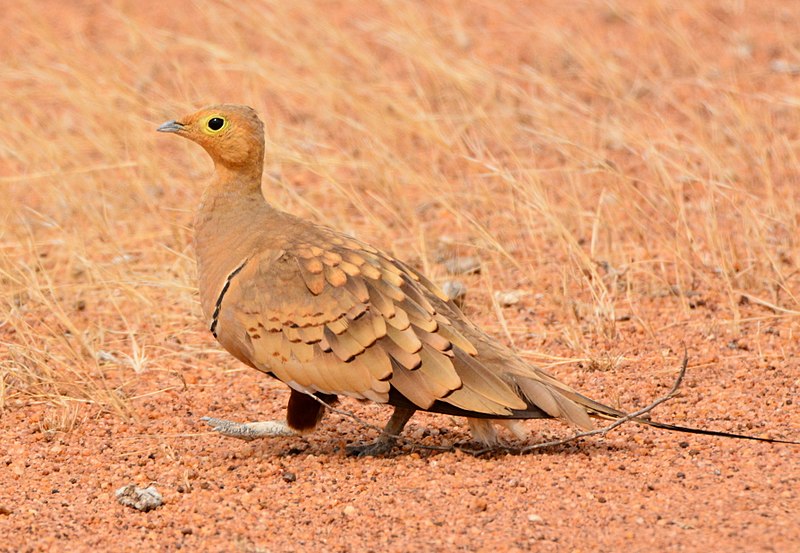
The Chestnut-bellied sandgrouse is a species of bird found in northern and central Africa, as well as western and southern Asia.
It has six recognised subspecies which differ in plumage colouration; males typically have mostly light buffy brown feathers with darker bars on the wings, while females are greyer with paler head markings.
These birds prefer semi-arid regions such as deserts or grasslands where they eat seeds from plants like grasses, herbs and shrubs.
They can be nomadic depending on food availability but tend to be sedentary during mating season when they form small groups called leks for courtship displays involving intricate feather ruffling and strutting around potential mates.
The Chestnut-bellied Sandgrouse is an important part of its native ecosystems due to their role in dispersing plant seeds over large areas through defecating them after ingestion.Scientific classification:
| Kingdom | Animalia |
| Phylum | Chordata |
| Class | Aves |
| Order | Pterocliformes |
| Family | Pteroclidae |
| Genus | Pterocles |
| Species | P. exustus |
Also Featured In: Oman Birds, Gujarati Birds
11. Yellow-Fronted Canary
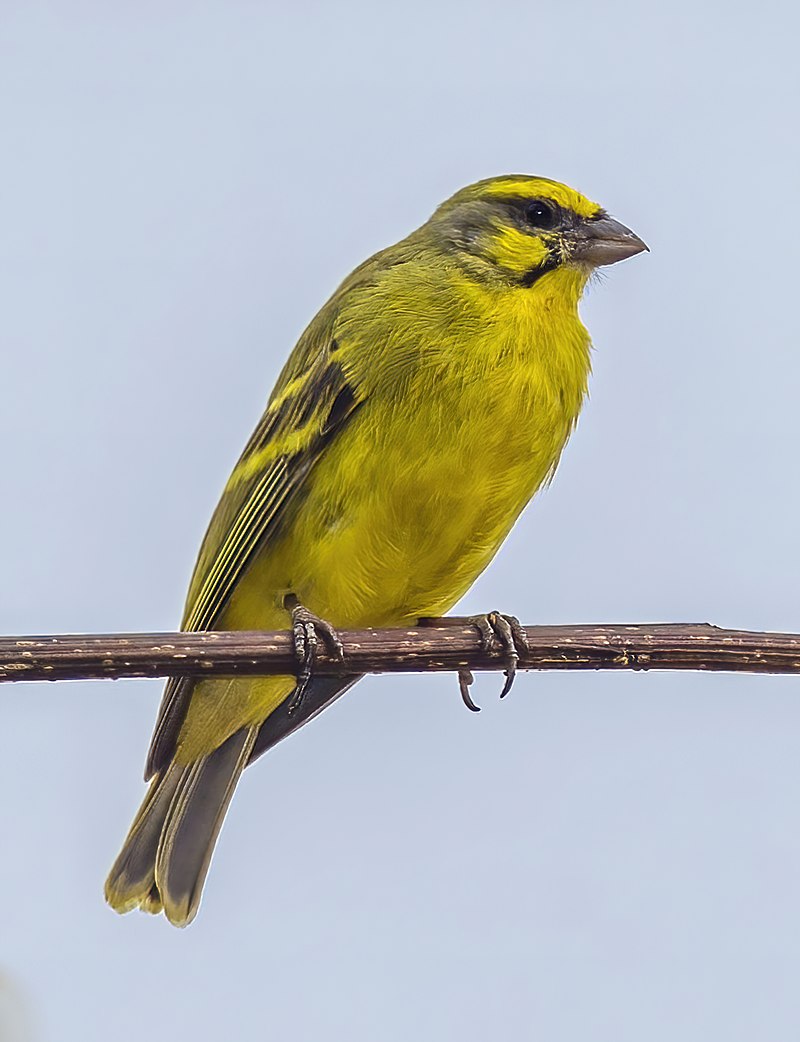
The Yellow-Fronted Canary is a small passerine bird in the finch family, often referred to as “the Green Singing Finch” by aviculturists.
It has bright yellow feathers around its head and face, with greyish-brown wings and tail.
This species was formerly placed within the Serinus genus but analysis of mitochondrial and nuclear DNA sequences revealed this grouping to be polyphyletic; thus it now stands alone in its own genus Crithagra mozambica.
The canary enjoys open woodlands or scrubland habitats where they are able to sing their beautiful songs from dawn until dusk – an activity which also serves as territorial behavior for males during mating season.
In addition, these birds feed on various grains such as grass seeds, buds & shoots of plants or even insects when possible.
With proper care & nutrition these lovely little birds can live up to 8 years making them a delightful pet choice.Scientific classification:
| Kingdom | Animalia |
| Phylum | Chordata |
| Class | Aves |
| Order | Passeriformes |
| Family | Fringillidae |
| Subfamily | Carduelinae |
| Genus | Crithagra |
| Species | C. mozambica |
Also Featured In: Mauritius birds, White Birds Commonly Found in Hawaii
12. Wandering Tattler
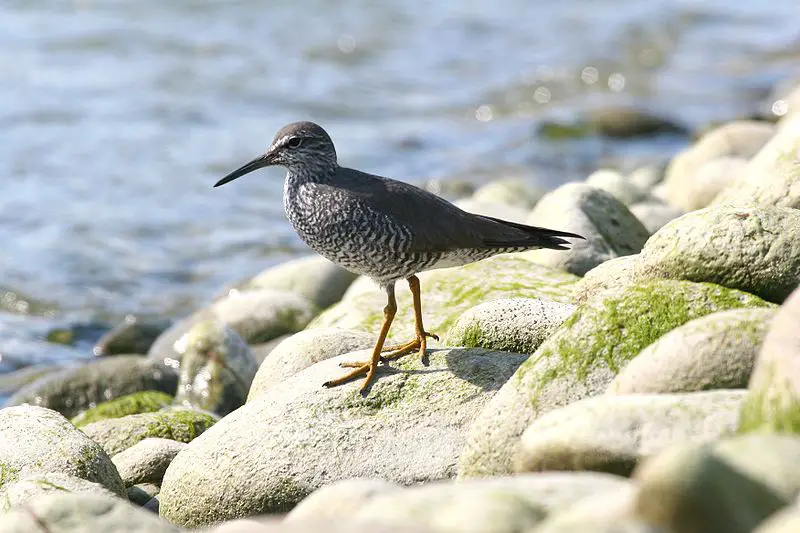
The Wandering Tattler is a medium-sized wading bird found in coastal areas throughout the world. It has unpatterned, greyish wings and back, as well as a scaly breast pattern that extends onto its belly.
Its closest relative is the Gray-tailed Tattler (Tringa brevipes). The species feeds on insects and crustaceans which they hunt along shorelines. They also take advantage of low tide to feed on exposed mudflats or sandbars.
During migration season these birds can be seen flying long distances over open ocean waters with their characteristic fluttering flight pattern before reaching land again to rest and refuel for another journey ahead.Scientific classification:
| Kingdom | Animalia |
| Phylum | Chordata |
| Class | Aves |
| Order | Charadriiformes |
| Family | Scolopacidae |
| Genus | Tringa |
| Species | T. incana |
Also Featured In: Cook Islands birds, Birds that Live in Sunshine Coast
13. Java Sparrow
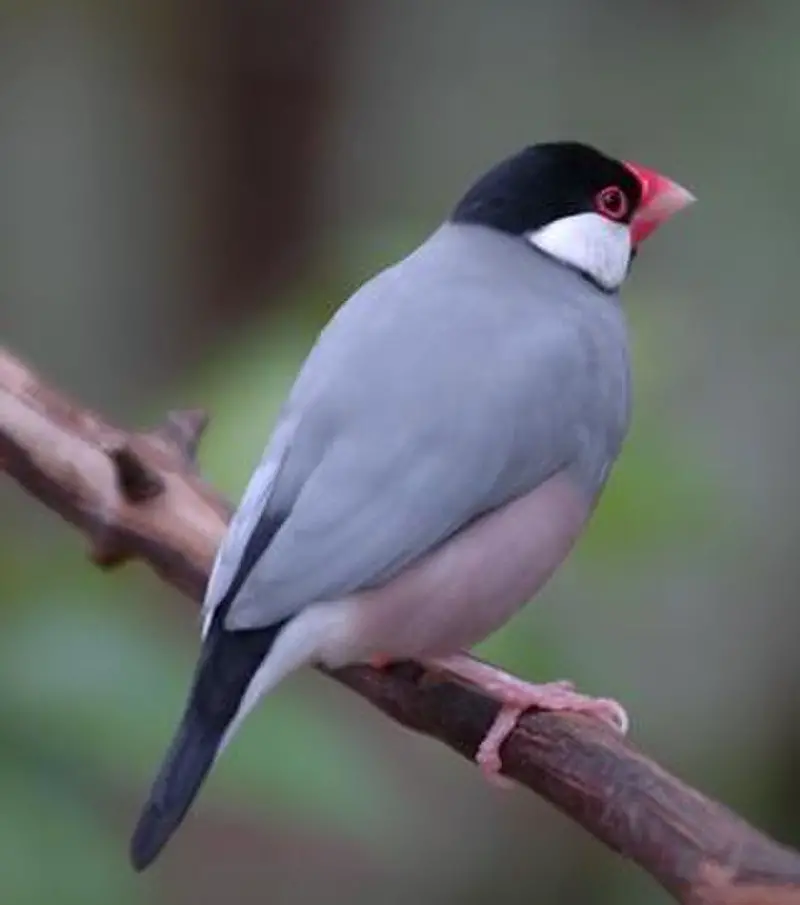
The Java sparrow is a small passerine bird that belongs to the estrildid finch family. It inhabits parts of Indonesia, including Java, Bali and Bawean islands, but has also been introduced in many other countries as a popular cage bird.
Its size can vary from 13–14 cm and it typically weighs around 20 grams. The feathers are brownish with white patches on its wings and tail while males feature black heads with pink or bluish beaks.
They feed mainly on grains like rice, millet or sorghum which explains their nickname “Java Rice Bird”; however they have also developed an appetite for insects when living close to human settlements.Scientific classification:
| Kingdom | Animalia |
| Phylum | Chordata |
| Class | Aves |
| Order | Passeriformes |
| Family | Estrildidae |
| Genus | Padda |
| Species | P. oryzivora |
Also Featured In: Finches Species, Aviary Birds You Should Know
14. Hawaiian Hawk

The Hawaiian hawk, or ʻio is an endemic raptor found only on the Big Island of Hawaii. It is one of two birds of prey native to the island – the other being a short-eared owl.
Evidence suggests that it once inhabited five islands in total but today can only be found on the Big Island.
This beautiful bird has distinctive white feathers and yellow legs and feet with its diet including small mammals, reptiles, insects and carrion which they hunt from above using their sharp vision.
The ‘Io plays an important role in keeping ecosystems balanced by controlling rodent populations as well as helping disperse seeds through consumption providing biodiversity for various plants across different regions within Hawaii’s forests and grasslands.Scientific classification:
| Kingdom | Animalia |
| Phylum | Chordata |
| Class | Aves |
| Order | Accipitriformes |
| Family | Accipitridae |
| Genus | Buteo |
| Species | B. solitarius |
Also Featured In: Hawaii Birds, Common Carnivore Birds
15. Hawaiian Petrel
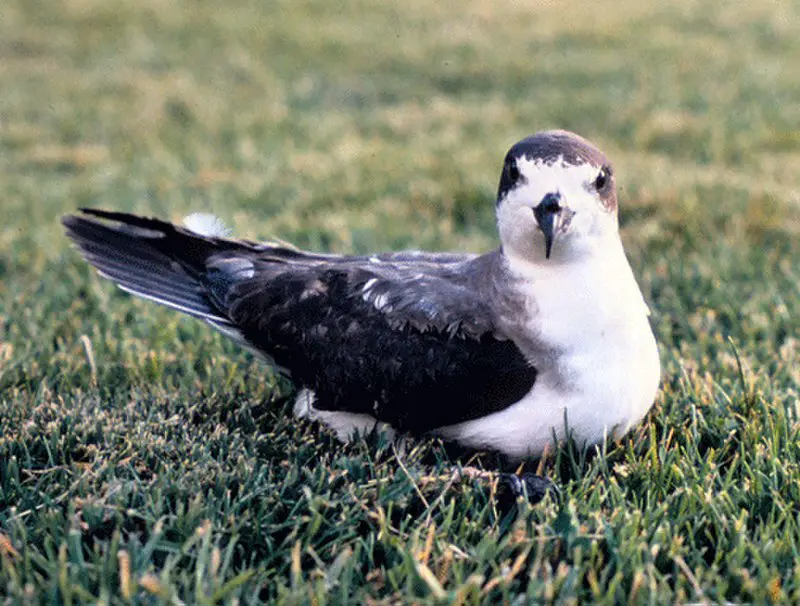
The Hawaiian petrel, or ʻuaʻu, is an endemic species to Hawai’i. Its striking dark gray-brown and white plumage makes it easily identifiable amidst the other birds of the islands.
It was once found on all main Hawaiian Islands except Niʻihau but has since been mostly restricted to Haleakalā crater on Maui with smaller populations inhabiting Mauna Loa on Hawai’i and Waimea Canyon and Lāna‘ihale on Kaua’i.
This seabird feeds mainly at night by diving into water for small fish, squid, octopus and crustaceans.
The female lays a single egg in burrows located up high in protected mountain slopes where they remain until fledging after 3 months of incubation period by both parents.
To ensure their continued survival these pets are protected from human activities through conservation efforts such as predator control programs that help protect newly hatched young from owls predating them before flight readiness.Scientific classification:
| Kingdom | Animalia |
| Phylum | Chordata |
| Class | Aves |
| Order | Procellariiformes |
| Family | Procellariidae |
| Genus | Pterodroma |
| Species | P. sandwichensis |
Also Featured In: Birds of Kauai, Hawaii, Birds that Found in Maui
16. Hawaiʻi ʻamakihi
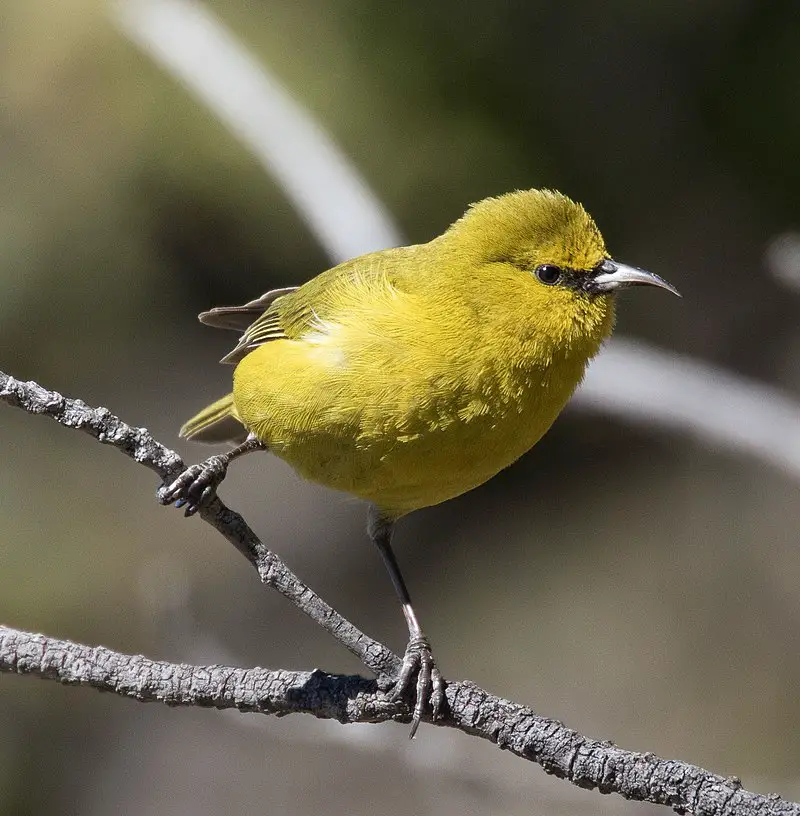
Hawaiʻi ʻamakihi is a species of Hawaiian honeycreeper belonging to the genus Chlorodrepanis.
It was previously placed in the Hemignathus group, but was reclassified based on mitochondrial and nuclear DNA sequences analysis.
The two recognized subspecies are C. v. wilsoni found on Maui, Molokaʻi, and Lanai; and C. vvirens occurring throughout Hawai’I Island except for Kona district where it has been extirpated due to habitat destruction from human activities such as urbanization and agriculture development.
The Hawaii amakihinest is mainly in lowland ōhi’a forest dominated by Metrosideros polymorpha trees at elevations up 900-1,800 meters (3,000–6,000 ft).
With its bright yellow breast feathers adorning its olive green body plumage, the Hawai` i `Amakihiflies gracefully through forests searching for nectar sources like flowers or insects.Scientific classification:
| Kingdom | Animalia |
| Phylum | Chordata |
| Class | Aves |
| Order | Passeriformes |
| Family | Fringillidae |
| Subfamily | Carduelinae |
| Genus | Chlorodrepanis |
| Species | C. virens |
Also Featured In: Most Common Oahu Birds,
17. ʻApapane
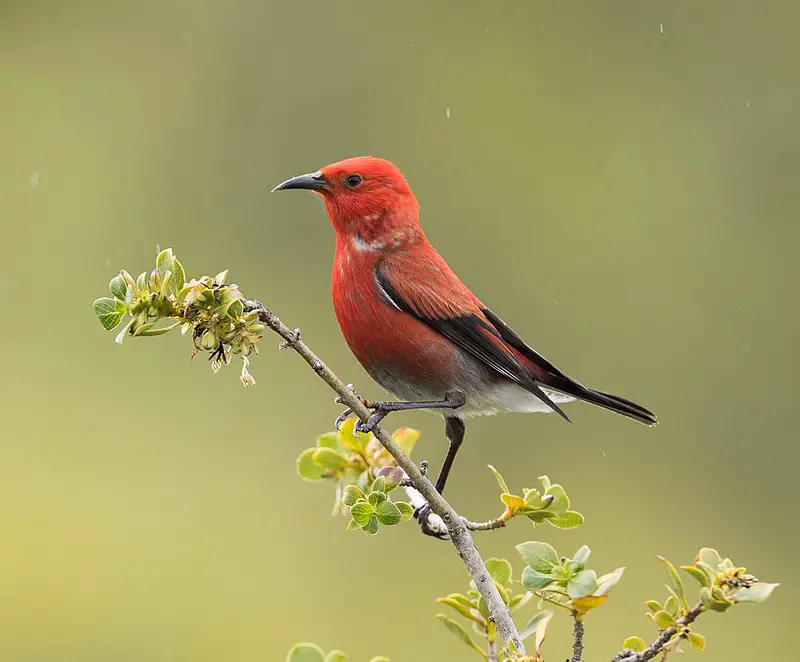
The ‘Apapane is a beautiful bird native to the Hawaiian Islands. It has bright crimson feathers and is a member of the honeycreeper family.
This small species can be found on all main islands, including Hawaiʻi, Maui, Lānaʻi, Kauaʻi, Molokaʻi and Oahu.
These birds are most commonly seen in ōhi’a trees where they feed off nectar from flowers as well as insects that live among the foliage.
They nest high up in these tall hardwood trees and also soar through rainforest treetops looking for food sources with their long wingspan.
The ‘Apapane’s vibrant coloration makes it an iconic symbol of Hawaii’s diverse wildlife landscape; its cheerful presence often bringing joy to visitors who have come to explore this tropical paradise.Scientific classification:
| Kingdom | Animalia |
| Phylum | Chordata |
| Class | Aves |
| Order | Passeriformes |
| Family | Fringillidae |
| Subfamily | Carduelinae |
| Genus | Himatione |
| Species | H. sanguinea |
Also Featured In: Red Birds that Found in the United States America, Native Birds Of Kure Atoll
18. ʻAkiapolaʻau
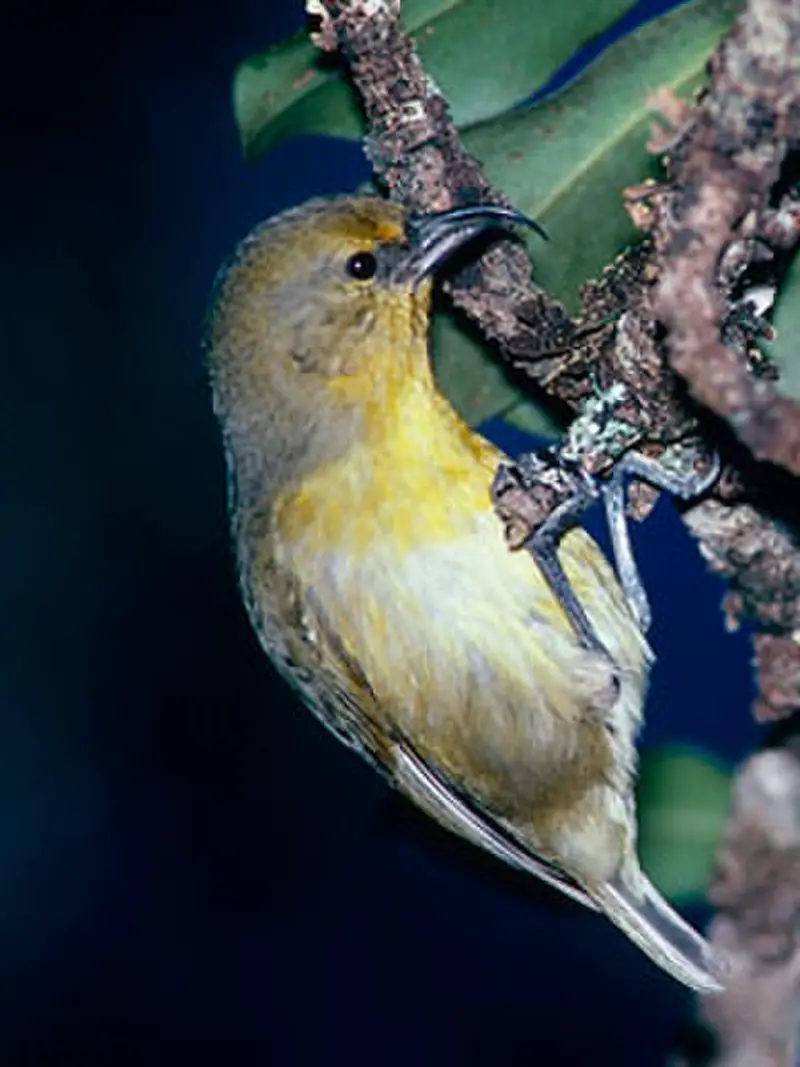
The ʻakiapōlāʻau is a species of Hawaiian honeycreeper that can only be found in the island of Hawaii.
It has an impressive 5.5 inch body and its most remarkable feature is its curved beak, making it the only bird on the island to occupy this niche.
The ‘Akiapola’au mainly lives in dry or moist forests and feeds off insects by using their unique bill to pry bark from trees for food sources.
They also use tools such as twigs and grasses when searching for invertebrates inside tree crevices.
Another interesting fact about this species is that they mate monogamously, meaning both parents take part equally into raising chicks together until they are mature enough to fly away independently.
All these features make them one of Hawaiis’s most fascinating endemic birds.Scientific classification:
| Kingdom | Animalia |
| Phylum | Chordata |
| Class | Aves |
| Order | Passeriformes |
| Family | Fringillidae |
| Subfamily | Carduelinae |
| Genus | Hemignathus |
| Species | H. wilsoni |
19. Hawaiʻi ʻakepa
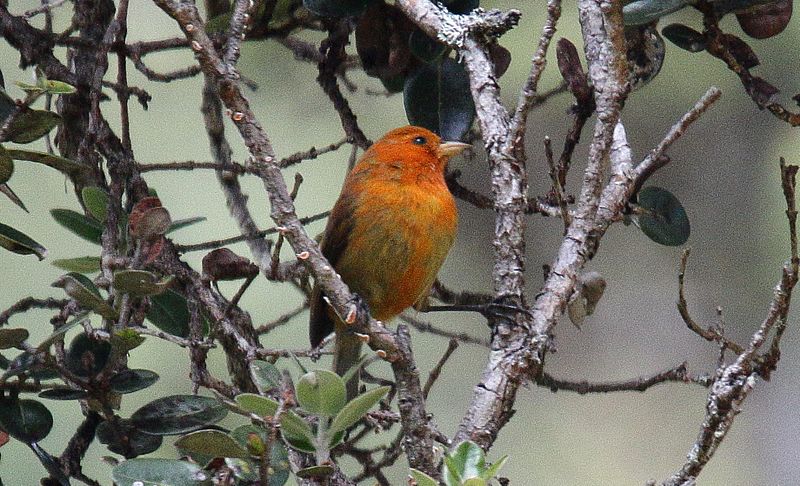
The Hawaiʻi ʻakepa is an endangered bird native to the Hawaiian Islands, first discovered by western science during Captain James Cook’s third voyage around the world.
It has striking red plumage and a unique call that can be heard echoing through its tropical forests habitats.
This species was only recently split from other Loxops coccineus birds in 2015 by the North American Classification Committee of the AOU.
The Hawai’i ‘Akepa are also known for their beautiful feather leis which were made with feathers collected during this expedition centuries ago.
Today, these lovely creatures face threats such as habitat destruction due to human activity and predation from non-native animals like rats and mongooses making them more vulnerable than ever before.Scientific classification:
| Kingdom | Animalia |
| Phylum | Chordata |
| Class | Aves |
| Order | Passeriformes |
| Family | Fringillidae |
| Subfamily | Carduelinae |
| Genus | Loxops |
| Species | L. coccineus |
20. Hawaiian Crow
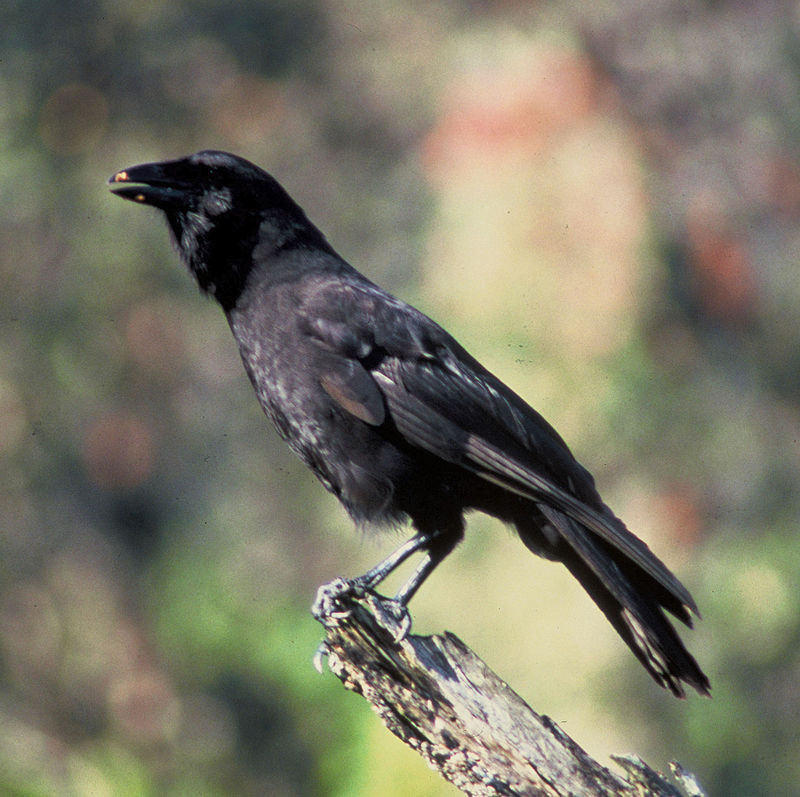
The Hawaiian crow, or ʻalalā, is an extinct species of bird from the family Corvidae. It was about 19-20 inches in length and had soft brownish-black plumage with long bristly throat feathers.
Its wings were rounded and its bill was much thicker than most other crows.
Reintroduction efforts are underway to attempt to return this species back into the wild where they once lived on all islands except Kaua’i many years ago.
The population has been decimated due to habitat destruction and predation by invasive mammals such as mongooses and cats but there is still hope that these birds can be saved through conservation measures like captive breeding programs which have already seen some successes.Scientific classification:
| Kingdom | Animalia |
| Phylum | Chordata |
| Class | Aves |
| Order | Passeriformes |
| Family | Corvidae |
| Genus | Corvus |
| Species | C. hawaiiensis |
21. Hawaiʻi ʻelepaio
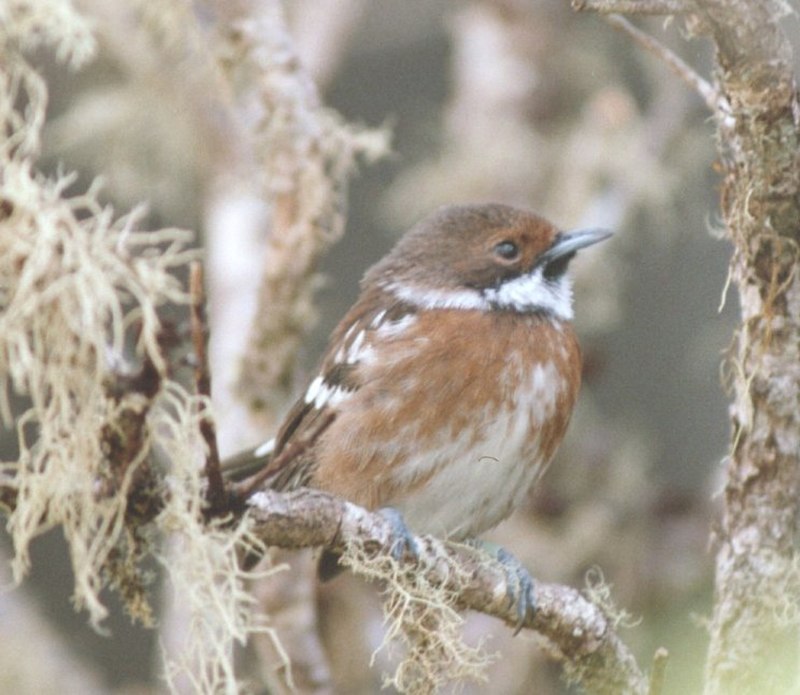
The Hawaiʻi ʻelepaio is a small bird native to the Big Island of Hawaii. It belongs to the monarch flycatcher family and until 2010, it was classified as one species alongside two other subspecies; Kauaʻi ʻelepaio and Oahu ʻelepaio.
This vibrant colored bird boasts black upperparts with white wingbars, a gray head and an orange-yellow breast.
It also has unique vocalizations which sound like “chee-dee” or “chup” while they are singing or searching for food in trees during their active daytimes.
The Hawai’i ‘Elepaios feed on insects such as beetles, spiders, caterpillars by gleaning them from foliage near ground level up into canopy layers of trees – making them difficult to spot.
Considering these birds have been around since before 1800s when first discovered by Europeans settlers – there’s no doubt that this beautiful creature will remain part of Hawaiian culture for years to come.Scientific classification:
| Kingdom | Animalia |
| Phylum | Chordata |
| Class | Aves |
| Order | Passeriformes |
| Family | Monarchidae |
| Genus | Chasiempis |
| Species | C. sandwichensis |
22. Palila
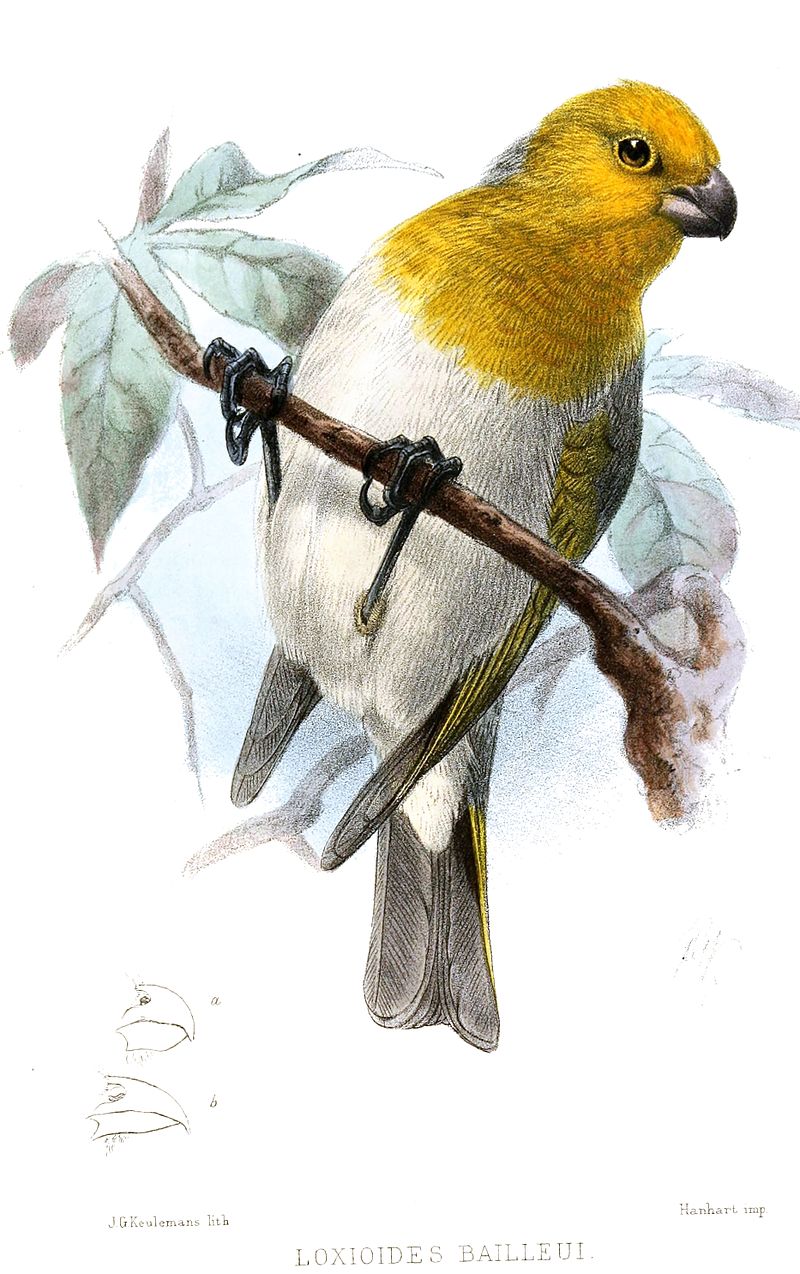
The Palila is a critically endangered species of Hawaiian honeycreeper, identified by its golden-yellow head and breast with a light belly, gray back and greenish wings and tail.
It has an incredibly close relationship to the Māmane tree (Sophora chrysophylla) in terms of habitat.
Unfortunately due to destruction of these trees as well as their accompanying dry forests, this bird became endangered – first noted when the very first specimen was collected in 1889.
Conservation efforts have been put into place since then but further protection for both birds and habitats must be implemented if we wish to keep this unique species from extinction.Scientific classification:
| Kingdom | Animalia |
| Phylum | Chordata |
| Class | Aves |
| Order | Passeriformes |
| Family | Fringillidae |
| Subfamily | Carduelinae |
| Genus | Loxioides |
| Species | L. bailleui |
23. Pacific Golden Plover
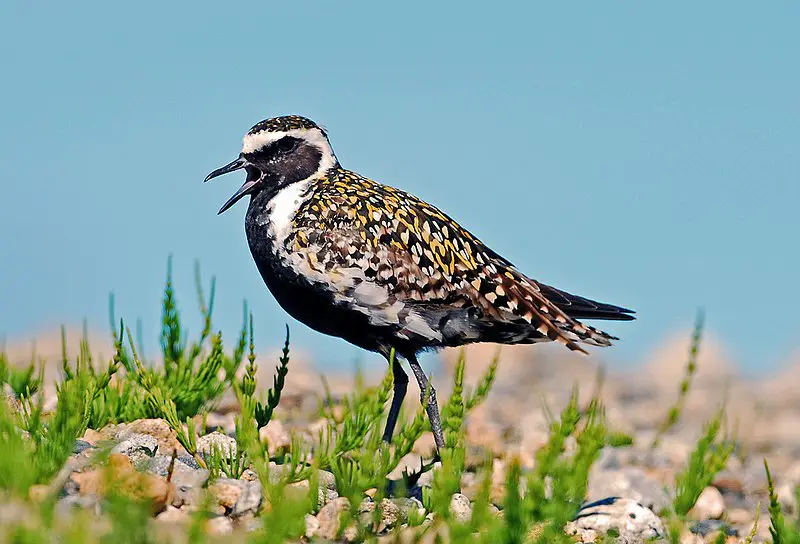
The Pacific golden plover (Pluvialis fulva) is an attractive migratory shorebird known for its breeding habits in Alaska and Siberia.
During the nonbreeding season, these medium-sized birds migrate widely across the Pacific.
It was formally described by Johann Friedrich Gmelin in 1789 as part of his revised edition of Carl Linnaeus’s Systema Naturae.
The species has a unique yellowish colouration with dark markings on their wings and back which gives them splendid camouflage against coastal rocks or sand beaches during migration periods.
They are omnivorous feeders who primarily eat insects, small crustaceans, worms and plant material like seeds or berries found along coastlines while migrating through various islands such as Hawaii, New Zealand etc.. A remarkable bird that possesses both beauty and resilience.Scientific classification:
| Kingdom | Animalia |
| Phylum | Chordata |
| Class | Aves |
| Order | Charadriiformes |
| Family | Charadriidae |
| Genus | Pluvialis |
| Species | P. fulva |
Also Featured In: Birds You’ll Find in Vancouver Island, Birds that Migrate to Sri Lankan
24. ʻŌmaʻo
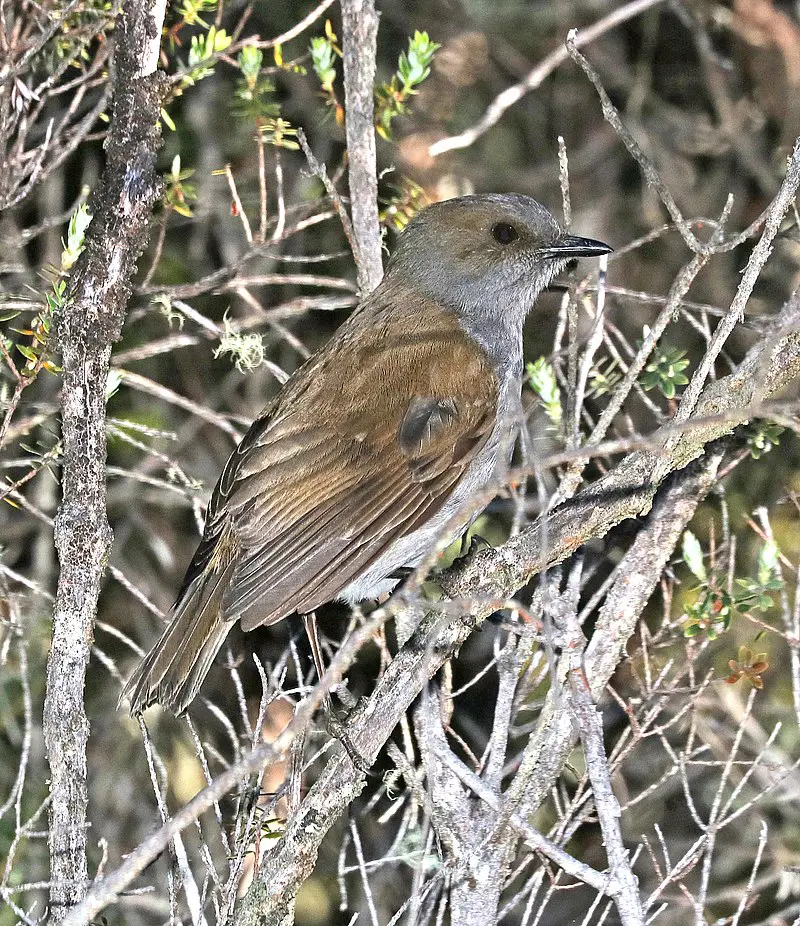
The ʻōmaʻo, also known as the Hawaiian thrush, is an endemic bird species native to Hawaii. It belongs to a family of robin-like birds that includes the kāmaʻo, oloma’o and puaiohi.
They are found primarily in rainforests on the Big Island’s eastern and southeastern regions.
Current population estimates suggest their numbers remain steady at around 10,000 individuals across various habitats such as dense understory vegetation in Kau forest reserves and more open areas like pastures or grassland slopes with scattered trees.
Though not currently threatened by extinction due to its wide range of suitable habitat types, human development has led to some decline in populations over time so conservation efforts are necessary for these unique birds’ continued survival.Scientific classification:
| Kingdom | Animalia |
| Phylum | Chordata |
| Class | Aves |
| Order | Passeriformes |
| Family | Turdidae |
| Genus | Myadestes |
| Species | M. obscurus |
25. Hawaiʻi Creeper
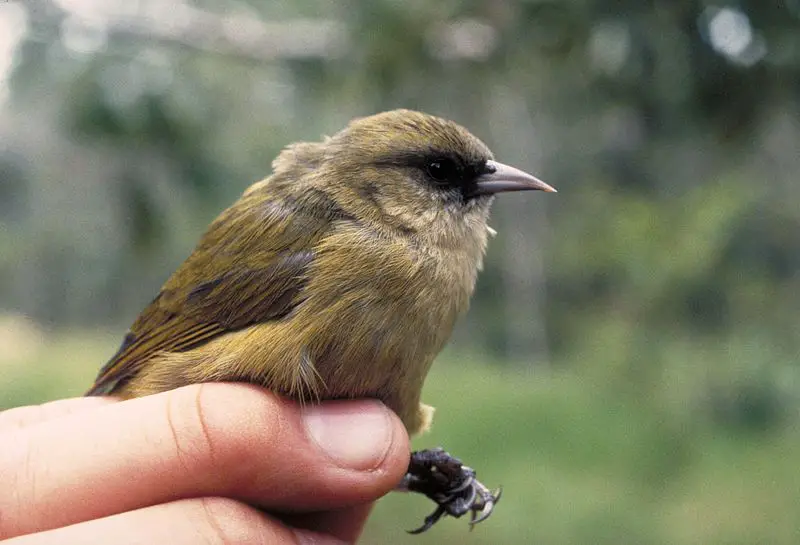
The Hawaiʻi creeper, also known as the ʻalawī, is an endemic Hawaiian honeycreeper species found exclusively on the Big Island. It inhabits two types of forests—dry and montane moist—at elevations between 1000-2300ft.
There are 12000 individuals spread over three populations with a potential fourth population in western parts of the island that may be migratory birds.
The bird has soft yellow plumage with olive green wings and back while its head is adorned by black facial markings running from eyes to bill base.
Its diet consists mainly of insects which it forages from tree branches or low shrubs in groups or pairs during daylight hours only.
This little beauty can often be heard singing its sweet trill song throughout forested areas making it one of Hawaii’s most beloved avian inhabitants.Scientific classification:
| Kingdom | Animalia |
| Phylum | Chordata |
| Class | Aves |
| Order | Passeriformes |
| Family | Fringillidae |
| Subfamily | Carduelinae |
| Genus | Loxops |
| Species | L. mana |
26. Hawaiian Duck

The Hawaiian duck, also known as Koloa, is an endemic bird of the large islands in Hawaii. It belongs to the Anatidae family and it is closely related to mallard ducks.
The main difference between these two species lies in their looks; while male and female Mallards have different colors, Hawaiian Ducks are monochromatic with similarly marked males and females.
This species does not migrate from its habitat either unlike other Anas genus ducks.
With a brownish-grey coloration on its body along with bright green head feathers, this beautiful creature can be seen mostly near ponds or vegetation areas around Hawaii’s coasts where they feed mainly on aquatic plants like algae and insects found there.Scientific classification:
| Kingdom | Animalia |
| Phylum | Chordata |
| Class | Aves |
| Order | Anseriformes |
| Family | Anatidae |
| Genus | Anas |
| Species | A. wyvilliana |
27. Erckel’s Spurfowl
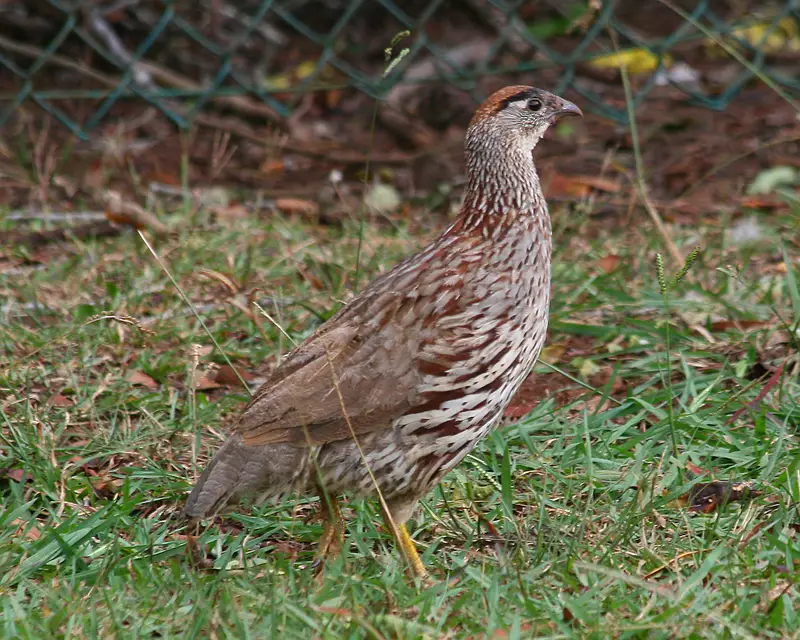
Erckel’s spurfowl is a species of game bird in the family Phasianidae. It was first described by German naturalist Eduard Rüppell, who named it after his assistant Theodor Erckel.
This beautiful bird has an array of colors – its plumage features shades of brown, white and black on its body with striking red wattles around their eyes and beak.
Their diet mostly consists of seeds, small insects like grasshoppers, beetles and termites as well as fruits found in forests or open areas near water bodies.
They are usually seen foraging alone or in pairs but can form large flocks during breeding season which takes place from February to June when males will perform courtship displays consisting of strutting along alternate routes while calling loudly to attract mates.
Erckel’s Spurfowl provides sport hunting opportunities throughout East Africa due to their abundance making them a popular quarry among hunters year-round.Scientific classification:
| Kingdom | Animalia |
| Phylum | Chordata |
| Class | Aves |
| Order | Galliformes |
| Family | Phasianidae |
| Genus | Pternistis |
| Species | P. erckelii |
28. Grey Francolin
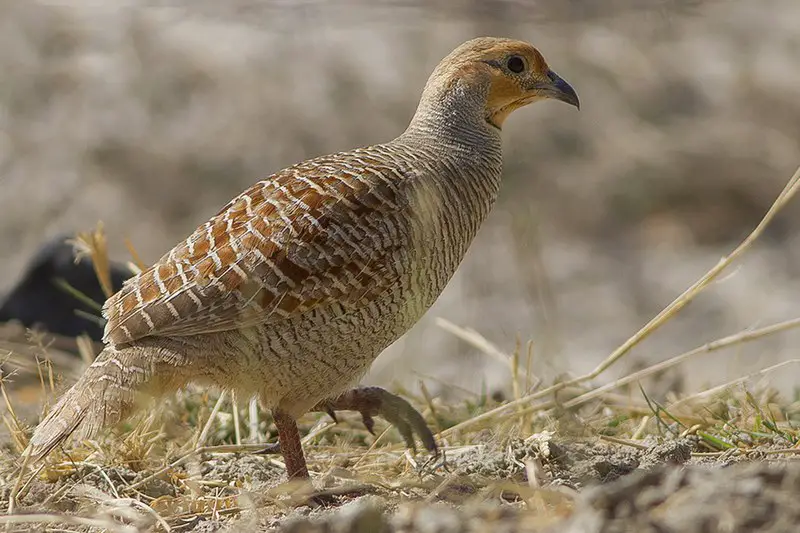
The Grey Francolin is a species of francolin found in the plains and drier parts of India, Iran and some other areas.
It was formerly called the grey partridge but should not be confused with European’s version.
This bird usually lives on ground where it finds open cultivated land. It has also been referred to as “manu moa” or “chicken bird”.
The colours can range from brownish-grey to dark grey along its body while there are black markings near its forehead area.
Its diet typically consists of seeds, leaves, insects and sometimes fruits too which they search for around bushes or tall grasses during early morning hours when these birds are most active.Scientific classification:
| Kingdom | Animalia |
| Phylum | Chordata |
| Class | Aves |
| Order | Galliformes |
| Family | Phasianidae |
| Genus | Ortygornis |
| Species | O. pondicerianus |
Also Featured In: Common Birds that Live in Odisha, Birds of Karnataka
29. Pueo
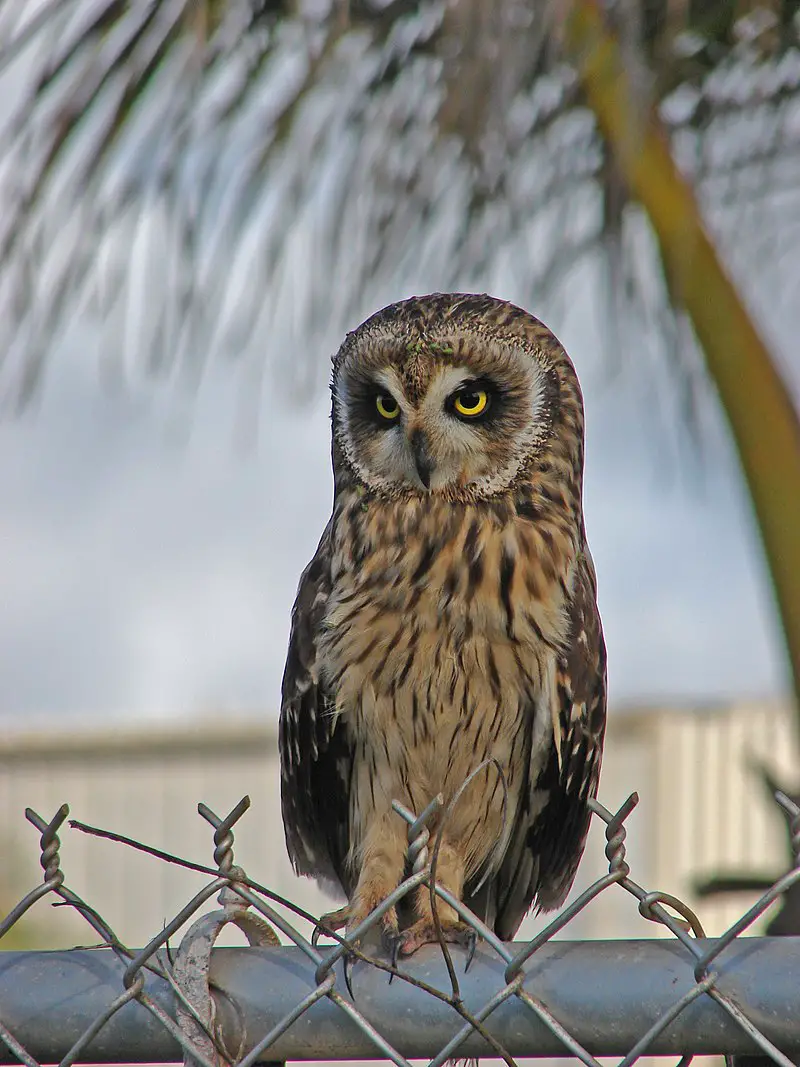
Pueo is a subspecies of the short-eared owl and is endemic to Hawaii. It has an important place in Hawaiian culture, as it often appears as ʻaumākua (ancestor spirits).
These birds live in forests and grasslands throughout the islands of Hawaiʻi. They are unfortunately becoming more rare due to habitat loss, but they continue to be deeply respected by local communities for their spiritual significance.
Pueo have unique physical characteristics such as yellow eyes, grayish brown feathers with white markings on its wings and head, long legs with feathered feet which help them hunt fast-moving prey like rodents during dusk or dawn hours.
Despite their declining numbers across Hawaii, pueos remain a beloved part of Hawaiian culture that still inspire awe today.Scientific classification:
| Kingdom | Animalia |
| Phylum | Chordata |
| Class | Aves |
| Order | Strigiformes |
| Family | Strigidae |
| Genus | Asio |
| Species | A. flammeus |
| Subspecies | A. f. sandwichensis |
30. Loxops
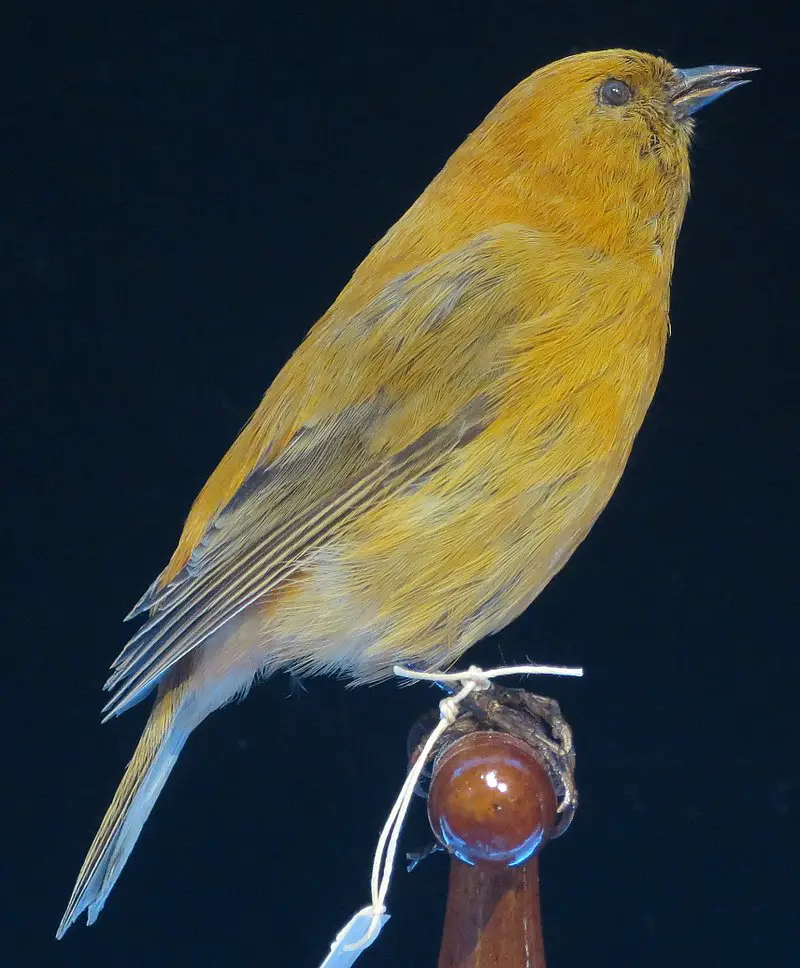
Loxops, also known as ʻakepa, is a genus of Hawaiian honeycreeper birds from the finch family. This genus includes five species, with two that are believed to be recently extinct or possibly extinct.
The Loxops genus is thought to have diverged from its closest relatives, the Chlorodrepanis ʻamakihis, during the earliest Pleistocene, approximately 2.47 million years ago, based on molecular analysis.
These birds are endemic to the Hawaiian archipelago and are known for their colorful plumage and unique beaks, which are adapted to their diet of nectar and insects.
Sadly, habitat destruction and introduced predators have contributed to the decline of many Loxops species, leading to their endangered status.
Conservation efforts are underway to help protect these beautiful birds for future generations to enjoy.Scientific classification:
| Kingdom | Animalia |
| Phylum | Chordata |
| Class | Aves |
| Order | Passeriformes |
| Family | Fringillidae |
| Subfamily | Carduelinae |
| Genus | Loxops Cabanis, 1847 |